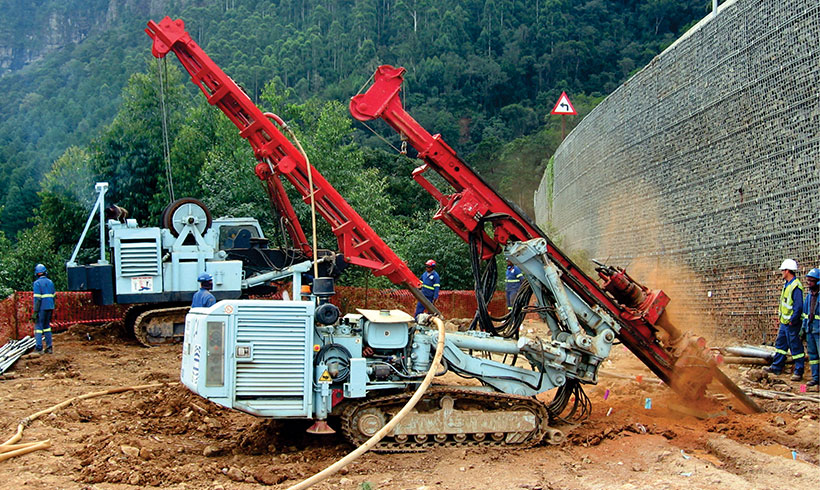Not known Facts About Specialized Geotechnical Engineering Solutions
Not known Facts About Specialized Geotechnical Engineering Solutions
Blog Article
Get This Report on Specialized Geotechnical Engineering Solutions
Table of ContentsThings about Specialized Geotechnical Engineering SolutionsSpecialized Geotechnical Engineering Solutions - TruthsThe Ultimate Guide To Specialized Geotechnical Engineering SolutionsWhat Does Specialized Geotechnical Engineering Solutions Mean?Some Ideas on Specialized Geotechnical Engineering Solutions You Need To KnowThe 8-Minute Rule for Specialized Geotechnical Engineering Solutions
William Rankine, an engineer and physicist, developed an alternate to Coulomb's earth pressure concept. Albert Atterberg developed the clay consistency indices that are still used today for soil category. In 1885, Osborne Reynolds identified that shearing reasons volumetric expansion of dense materials and tightening of loosened granular products. Modern geotechnical design is claimed to have started in 1925 with the magazine of Erdbaumechanik by Karl von Terzaghi, a mechanical engineer and rock hound. Terzaghi also developed the framework for concepts of birthing capacity of foundations, and the theory for forecast of the price of negotiation of clay layers due to loan consolidation. After that, Maurice Biot fully created the three-dimensional soil combination theory, expanding the one-dimensional design formerly developed by Terzaghi to more general theories and presenting the set of basic formulas of Poroelasticity.
Geotechnical designers investigate and figure out the properties of subsurface problems and products.
The smart Trick of Specialized Geotechnical Engineering Solutions That Nobody is Discussing
Geologic mapping and interpretation of geomorphology are usually completed in examination with a geologist or engineering geologist. Subsurface exploration normally entails in-situ testing (for example, the standard penetration test and cone penetration examination). The excavating of examination pits and trenching (specifically for situating faults and slide planes) may also be used to learn more about dirt conditions at deepness. , which uses a thick-walled split spoon sampler, is the most typical means to gather disturbed examples.

If the interface between the mass and the base of an incline has a complicated geometry, incline stability analysis is hard and numerical solution techniques are needed. Normally, the user interface's precise geometry is unknown, and a streamlined user interface geometry is presumed. Finite slopes call for three-dimensional versions to be assessed, so most slopes are assessed thinking that they are considerably broad and can be stood for by two-dimensional versions.
10 Easy Facts About Specialized Geotechnical Engineering Solutions Described

Dimension of quantities and assessment of actual problems. Design adjustment per real conditions The empirical technique is appropriate for building go to the website that has currently started when an unexpected growth happens or when a failure or accident looms or has currently happened. It is inappropriate for jobs whose layout can not be changed throughout building.
Concepts of Geotechnical Engineering. Dirt Mechanics and Foundations. Disrupted dirt buildings and geotechnical design, Schofield, Andrew N., Thomas Telford, 2006.
The Basic Principles Of Specialized Geotechnical Engineering Solutions
and get more Kovacs, W. (1981 ), An Intro to Geotechnical Engineering, Prentice-Hall, Inc. Deep Scan Technology (2023 ): Deep Check Tech uncovers covert frameworks at the website of Denmark's tallest structure. "Geofrost Coring". GEOFROST. Recovered 20 November 2020. Han, Jie (2015 ). Principles and Practice of Ground Enhancement. Wiley. ISBN 9781118421307. RAJU, V. R.
Ground Improvement Technologies and Case Histories. Singapore: Research Publishing Providers. p. 809. ISBN 978-981-08-3124-0. Ground Enhancement Principles And Applications In Asia. Pariseau, William G. (2011 ). Style analysis in rock mechanics. CRC Press. Hegde, A.M. and Palsule P.S. (2020 ), Performance of Geosynthetics Reinforced Subgrade Subjected to Repeated Vehicle Plenties: Speculative and Numerical Researches.
Cengage Discovering, Stamford, 666 p. Atkinson, J., 2007. The auto mechanics of soils and structures. The Observational Technique in ground engineering principles and applications.
Specialized Geotechnical Engineering Solutions Things To Know Before You Buy
These records are customized to satisfy the particular demands of a job and consist of style criteria and guidance for the construction of a range of man-made frameworks. Along with providing working as a consultant solutions covering areas such as incline stability and load-bearing capabilities for various products, these designers carry out r & d tasks to enhance approaches, devices, materials knowledge and evaluation covering whole lifecycles (Specialized Geotechnical Engineering Solutions).
Engineering the properties and auto mechanics of rocks consisting of the application of dynamics, fluid mechanics, kinematics and product technicians. This combines geology, soil and rock technicians, and structural engineering for the layout and building and construction of structures for an array of civil design jobs. This field entails forecasting the performance Specialized Geotechnical Engineering Solutions of structure dirt and rock to a load imposed by a structure, while taking into consideration performance, economy and safety.
Prices of pay generally increase as your knowledge and abilities expand, with guidelines pointing to a graduate starting salary of in between 18,000 and 28,000 per year in the UK. This climbs to 26,000 to 36,000 with a few years of experience and afterwards reaching 40,000 to 60,000+ for senior, chartered or master engineers.
8 Simple Techniques For Specialized Geotechnical Engineering Solutions
With the ideal application it is feasible to grasp the profession and gain entrance to a tough yet gratifying and essential job. A geologist would need to retrain to come to be a geotechnical engineer, although there is a lot of cross-over in between the 2 careers, which might make this much easier. Rock hounds require to have an understanding of soils, rocks and various other materials from a scientific perspective, while geotechnical designers story their understanding of matters such as soil and rock technician, geophysics and hydrology and use them to design and environmental jobs.
When beginning, these engineers will certainly tend to work with less intricate tasks, developing up expertise and experience prepared for more difficult work later. Geotechnical designers often tend to be experts in certain locations as they expand in experience, concentrating on particular infrastructures such as trains, roadways or water. These engineers also function with eco-friendly power, offshore and onshore oil and gas, nuclear power, and a lot more.
Report this page